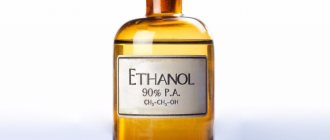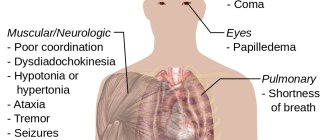MINISTRY OF HEALTH OF THE RUSSIAN FEDERATION
PHARMACOPOEIAL ARTICLE
Ethyl alcohol 95%, 96% FS.2.1.0036.15
Ethanol Instead VFS 42-2761-96;
Ethanolum in replacement of FS 42-3072-00
Ethanol
C2H6O M. m. 46.07
Ethyl alcohol 95% contains from 94.9% to 96.0% ethanol C2H6O (v/v), from 92.3% to 93.8% (m/m); ethyl alcohol 96% contains from 95.1% to 96.9% ethanol (v/v), from 92.6% to 95.2% (m/m).
This pharmacopoeial article applies to ethyl alcohol 95% and ethyl alcohol 96%, produced from various types of sugar- and starch-containing food raw materials and used for the production/manufacturing of sterile and non-sterile dosage forms.
Aldehydes
No more than 0.00025% (v/v) (no more than 2 mg/l) in terms of anhydrous ethyl alcohol.
Determination is carried out by GC method. Chromatography conditions are given in the “Methanol” section.
The content of aldehydes (acetaldehyde) in substance (X) in percent (v/v) in terms of anhydrous ethyl alcohol is calculated using the formula:
Where
S – peak area of acetaldehyde in the chromatogram of the substance;
S0 – peak area of acetaldehyde in the chromatogram of the calibration mixture;
C – concentration of acetaldehyde in the calibration mixture, mg/l;
ρ is the density of acetaldehyde, equal to 0.783 g/ml;
P – ethyl alcohol content in the substance, % (v/v), calculated based on the density of the substance.
Bibliography
- Pharmaceutical technology. Technology of dosage forms: textbook. for students higher textbook institutions / [I.I. Krasnyuk, S.A. Valevko, G.V. Mikhailova, etc.] ; edited by I.I. Krasknyuk, G.V. Mikhailova. – 3rd ed., revised. and additional – M.: Publishing House, 2007. – 592 p.
- State Pharmacopoeia of the USSR. – 11th ed. – T.1. – M.: Medicine, 1987. – 336 p. T.2. – M.: Medicine, 1987. – 400 p.
- XII State Pharmacopoeia of the Russian Federation / Publishing House “Scientific Center for Expertise of Medicinal Products”, 2008. – 704 pp.: ill.
- Orders of the Ministry of Health of the Russian Federation No. 308 of 1997, 214 of 1997, 305 of 1997, 309 of 1997, 110 of 2007.
All formulas are given in the document, which you can download from the link >>>
There is also a presentation on this abstract >>>
Esters
Not more than 0.0011% (v/v, not more than 10 mg/l) in terms of anhydrous ethyl alcohol.
Determination is carried out by GC method. Chromatography conditions are given in the “Methanol” section.
The content of esters (methyl acetate, ethyl acetate) in substance (X) in percent (v/v) in terms of anhydrous ethyl alcohol is calculated using the formula:
Where
Хi – concentration of each ester, calculated by the formula:
Where
Si – peak area of each ester (methyl acetate, ethyl acetate) in the chromatogram of the substance;
S0 – peak area of each ester (methyl acetate, ethyl acetate) on the chromatogram of the calibration mixture;
Сi – concentration of each ester (methyl acetate, ethyl acetate) in the calibration mixture, mg/l;
ρi is the density of each ester, equal to 0.924 g/ml for methyl acetate and 0.901 g/ml for ethyl acetate, respectively;
P – ethyl alcohol content in the substance, % (v/v), calculated based on the density of the substance.
Content
- 1 Preparation 1.1 Fermentation 1.1.1 Industrial production of alcohol from biological raw materials
- 1.1.2 Hydrolysis production
- 2.1 Physical properties
- 3.1 Fuel
- 5.1 Vehicle fleet running on ethanol
- 9.1 Etymology of the term "ethanol"
Fusel oil
No more than 0.0006% (v/v) (no more than 5 mg/l) in terms of anhydrous ethyl alcohol.
Determination is carried out by GC method. Chromatography conditions are given in the “Methanol” section.
The content of fusel oil (propanol, 2-propanol, isobutyl alcohol, butanol, isoamyl alcohol) in substance (X) in percent (v/v) in terms of anhydrous ethyl alcohol is calculated using the formula:
Where
ХI – concentration of each component of fusel oil, calculated by the formula:
Where:
Si – peak area of each component of fusel oil (propanol, 2-propanol, isobutyl alcohol, butanol, isoamyl alcohol) on the chromatogram of the substance;
S0 – peak area of each component of fusel oil (propanol, 2-propanol, isobutyl alcohol, butanol, isoamyl alcohol) on the chromatogram of the calibration mixture;
Ci is the concentration of each component of fusel oil (propanol, 2-propanol, isobutyl alcohol, butanol, isoamyl alcohol) in the calibration mixture, mg/l;
ρ i is the density of each component of fusel oil, equal to 0.804 g/ml for propanol, 0.785 g/ml for 2-propanol, 0.803 g/ml for isobutyl alcohol, 0.810 g/ml for butanol and 0.812 g/ml for isoamyl alcohol, respectively;
P – ethyl alcohol content in the substance, % (v/v), calculated based on the density of the substance.
Alcohol recipe in Latin: step-by-step instructions
A recipe for alcohol in Latin begins, like any other recipe in Latin, with the word Recipe (abbreviated in all recipes - Rp.), which means “take.”
Rp.
Further, after the colon, it is necessary to indicate the dosage form of the substance in the genitive case and in the singular. In our case, it will always be a solution, since alcohol is used only in solution. In Latin it looks like this: Solutionis - (abbreviated - Sol.). Read more about the recipe for the solution in Latin.
Rp.: Sol.
Then we write the word alcohol in Latin in the singular and in the genitive case: Spiritus aethylici. Yes, it does not change in the genitive case.
Rp.: Sol. Spiritus aethylici
After which you need to indicate the percentage of our alcohol and the volume in milliliters, for example, let’s take a solution of 70% - 200 ml.
Rp.: Sol. Spiritus aethylici 70% – 200 ml
On a new line we write Da tales doses numero (abbreviated as Dtd N), which means “give out in this quantity” and indicate how many (for example, 12 pieces) and in what (in bottles - in flacconis - in flacc.) you need to give out: Dtd N 12 in flacc. It is not necessary and even undesirable to indicate “in bottles”; you will learn more about this in the article recipe for bottles in Latin.
Rp.: Sol. Spiritus aethylici 70% – 200 ml Dtd N 12
On a new line we write Signa (abbreviated S.), which translates as “designate”, put a colon and write how to use our alcohol to the patient.
Rp.: Sol. Spiritus aethylici 70% – 200 ml Dtd N 12 S. Use for disinfection
Alcohol can also be prescribed as part of other medicines, for example:
Rp.: Lotionis Zinci spirituosae 100.0 (zinc-alcohol lotion) DS for wiping chafed skin areas
Reducing agents
Cobalt chloride solution. 2.5 g of cobalt chloride is placed in a 50 ml volumetric flask, dissolved in water, 0.1 ml of concentrated hydrochloric acid is added, the volume of the solution is adjusted to the mark with water and mixed.
Potassium dichromate solution. 0.100 g of ground potassium dichromate, previously dried to constant weight at a temperature of 100 - 105 ° C, is dissolved in water in a 500 ml volumetric flask, the volume of the solution is adjusted to the mark with water and mixed.
Standard solution. 5 ml of cobalt chloride solution is placed in a 100 ml volumetric flask, 7 ml of potassium dichromate solution is added, the volume of the solution is adjusted to the mark with water and mixed.
0.02% potassium permanganate solution. 0.02 g of potassium permanganate is dissolved in 100 ml of water.
50 ml of the substance is placed in a cylinder with a ground-in stopper, pre-rinsed with the test alcohol, and immersed for 10 minutes in a water bath at a temperature of 15 ° C so that the water level in the bath is higher than the level of alcohol in the cylinder. Add 1 ml of 0.02% potassium permanganate solution, close the cylinder with a stopper, mix and immerse again in the bath. When standing, the red-violet color of the mixture gradually changes and should not reach the color of the standard solution within 20 minutes.
Use of alcohol in medicine
Ethanol is an aliphatic monohydric alcohol with the empirical formula C2H6OH. The pure substance is a colorless, flammable liquid with a pungent taste and a characteristic, spicy (sweetish) odor.
Alcohol is on the World Health Organization's list of essential medicines as the most effective and safe drug needed in the healthcare system.
The therapeutic index of ethanol is 10:1, which is not very high. Alcohol is used in medicine as a disinfectant, antidote and solvent.
Alcohol as a disinfectant
You can disinfect anything with alcohol: from the hands of medical workers, continuing with the skin before an injection or before surgery, and ending with work surfaces.
Efficacy as a disinfectant or antiseptic depends on the concentration of the ethanol-water mixture. With an optimal alcohol content of 50 to 80%, the bacterial membrane is destroyed. All bacteria, including tuberculosis pathogens, die within a minute by denaturing the bacterial cell wall (bactericidal effect).
It is interesting that when using anhydrous ethanol, bacteria do not die; it only promotes the hardening of their bacterial membrane.
Alcohol is not effective against viruses and bacterial endospores. However, combination with alkalis (about 1%) or peroxycarboxylic acids (0.2 to 0.5%) significantly increases its effectiveness against them.
Alcohol should not be used on open wounds.
In addition to the unpleasant burning sensation, ethanol (mainly when applied to the skin) has a vasodilating effect . This effect generally helps clean wounds, but can significantly worsen bleeding, especially with larger injuries.
The use of alcohol solutions of more than 80% has an even stronger effect, but due to lack of skin tolerance they are rarely used.
Drinking ethanol or alcoholic beverages do not have an antiseptic effect. Drinks containing less than 20% ethanol do little to kill bacteria.
95% or pure ethanol can melt thyroid nodules (so-called PEI therapy – Perkutane Ethanol-Injektionstherapie) and other tumors such as hepatocellular carcinoma.
Alcohol as an antidote
Ethanol can be administered orally and/or intravenously in cases of methanol poisoning. As an antidote, it inhibits the conversion of methanol, through the enzyme alcohol dehydrogenase, into toxic methanal. Ethanol binds approximately 25 times more alcohol dehydrogenase than methanol.
In case of severe alcohol dependence and prolonged binge drinking with ethanol, delirium tremens can be interrupted.
Legal registration
Ethanol production is carried out by an organization that has a paid authorized capital of at least 10 million rubles. Warehouse, production and other premises must be owned by the manager, under economic management or leased (agreement for a period of 1 year or more).
Order No. 167n dated October 30, 2022 approved the application form for state registration of equipment for ethanol production.
A business requires registration with the tax service, obtaining a license, certificate, and connection to the Unified State Automated Information System.
Registration
LLC, PJSC is suitable for this activity. The only possible taxation system is OSNO. There is no need to write an application. Businessmen who have not declared their choice automatically switch to this mode upon initial business registration.
The following types of taxes are paid:
- corporate income tax (20% of net income);
- VAT (20%);
- corporate property tax (set by local authorities, up to 2.2%);
- excise tax (a fixed amount per liter of anhydrous product, payable under certain conditions).
Main OKVED code: 11.01.4 Production of edible alcohol.
Additional OKVED codes:
- 46.34.22. Wholesale trade in food grade ethyl alcohol.
- 52.10.3. Storage and warehousing of grain.
- 52.10.23. Storage and warehousing of other liquid or gaseous cargo.
Excise tax
Ethyl alcohol produced from food or non-food raw materials is an excisable product. Regulated by Chapter 22 of the Tax Code of the Russian Federation.
When selling goods to organizations that are responsible for paying excise tax, as well as to companies engaged in the production of alcohol-containing perfumes, medicines, and household chemicals, the seller does not pay this tax. The following rates are provided for taxpayers (based on 1 liter of anhydrous alcohol), in rubles:
- 544 (from January 1 to December 31, 2022);
- 566 (from January 1 to December 31, 2022);
- 589 (from January 1 to December 31, 2022).
There is a special declaration form for excise duty.
EGAIS
One of the requirements when working with excisable goods is the connection of the EGAIS system. Registration will be required on the official website of the Federal Service for Regulation of the Alcohol Market of the Russian Federation. The businessman is assigned a unique identification number, which is indicated when issuing the invoice. You will also have to purchase an electronic digital signature and install UTM - a universal transport model (you can also launch it through the goods accounting program).
License
To obtain a license, the following documents must be presented:
- a statement indicating the name of the organization, legal form and other information;
- copies of constituent documents;
- a copy of the state registration certificate;
- receipt of payment of state duty;
- copy of registration with the Federal Tax Service and others.
The license is issued by the Federal Service for Alcohol Regulation. Preliminary control authorities conduct an examination and provide conclusions based on them. The license is issued for a period of 1 to 5 years, then renewal is required. Price - 800,000 rubles.
Certificate
The presence of a certificate confirms the product’s compliance with the requirements of State standards. Receipt procedure:
- Contacting a certification center.
- Submitting an application for product declaration.
- Submission of a package of documents.
- Sampling.
- Conducting laboratory research.
- Drawing up a conclusion based on the results of examinations.
- Issuance of a certificate.
The validity period of the document is determined by the technical regulations. The cost of the certificate is about 8,000 rubles.
Rectification technology
When you have acquired everything you need, and the barometer shows the norm, you can begin the rectification process.
If you have a suitable device, your participation will be minimal.
- Pour in raw alcohol.
- We install the column and close the atmospheric fitting and the final product outlet fitting.
- Let's start heating.
- For some time the column “works for itself.”
- Then we open the fittings and let the final product come out.
What happens in the column?
During the internal work, the raw alcohol vapor evaporates, then cools and flows down. Then they heat up again and cool again and flow down again. A low-boiling pure alcohol fraction accumulates in the upper part, which condenses in the refrigerator. This process is called heat and mass transfer. During this “cycle of substances,” a pure alcohol fraction is released, almost without impurities.
The internal work process takes on average from 10 to 30 minutes, depending on the height and design of the column. The instructions for the apparatus or column must indicate the time required for “self-employment”.
Distillation column "Priyatel" with a stainless steel tank - a complete set for the preparation of high-quality alcohol
When to open?
There are two thermometers installed on the column in its lower and upper parts. They allow you to track the progress of the process. When the readings at the top and bottom are equal, equilibrium is established in the column. The stage of internal work of the column can be considered completed.
At this moment we open the atmospheric fitting and the distillate outlet fitting. The final product begins to flow into the prepared container. We use an alcohol meter to check the strength of the finished drink. If everything is done correctly, the strength will be about 96 degrees. If the strength of the product is 90 degrees or lower, then you opened the atmospheric fitting and tap early.
As a rule, early opening of fittings is the main reason for lowering degrees.
This is what a molecule of pure ethanol looks like, which you will get as a result of properly carried out rectification
And again about the atmospheric fitting
When you open the atmospheric fitting, atmospheric pressure acts on the alcohol vapor. The pressure is equalized between the column and the environment. Without pressure balance we will not receive a rectification. Therefore, if the device does not have an atmospheric fitting, then obtaining alcohol is simply impossible.
What you need to know about wine filtration?
- Filtration is important. Through the filtering process, wine becomes not only clean and transparent. During preparation, dust, fungi, seeds and other small particles will get into the drink. After all, according to the rules, grapes and other fruits are not washed, preserving natural yeast. If filtering is not carried out, the wine may become unfit for consumption.
- Winemakers claim that a place for filtration can be found at any stage of preparation. Then the question needs to be posed differently: what kind of wine will be obtained after passing through the filter at a certain stage?
- There is coarse, fine, acute and final warranty filtration. Experienced winemakers filter the result of their labor using special devices.
- When straining wine, you need to monitor the amount of sediment. It doesn't always require as many steps as described in the recipe. First you need to learn how to strain homemade wine at home.
How to distinguish drinking ethanol from technical ethanol
Unfortunately, the high price of a bottle of vodka does not guarantee its quality. Alcohol is easy to counterfeit, just get similar labels and containers, and “elite” sawdust booze (at best) is ready. Stores also do not hesitate to buy cheaper goods, so the risk of poisoning is not excluded, even if we buy alcohol in beautiful “rich” packaging.
Our readers recommend! To quickly and reliably get rid of alcoholism, our readers advise. This is a natural remedy that blocks cravings for alcohol, causing a persistent aversion to alcohol. In addition, Alcobarrier triggers restoration processes in organs that alcohol has begun to destroy. The product has no contraindications, the effectiveness and safety of the drug has been proven by clinical studies at the Research Institute of Narcology.
To reduce this risk, it is better to make such purchases in hypermarkets, chain stores or specialized stores. In a word, this should be a point of sale that values its reputation, and to which, if anything happens, you can make a claim (most importantly, keep your receipts). You should avoid stalls, market tents, and dubious private outlets. Such sales points like to disguise themselves as “confiscated goods,” thus explaining the low price of such a “good product.”
The purchased alcoholic drink should be set on fire before drinking. Just pour a little product into a tablespoon and light it. If it burns with a translucent blue flame, we have ethanol (although what it is made of remains unknown). If the flame gives off a greenish tint, it is poisonous industrial alcohol.
If you want to check the quality of your favorite brand of vodka or the one you just bought, a potato wedge will help. Place a piece of peeled potato into a glass of alcohol and leave it for a couple of hours. If the root vegetable has not changed its color, the drink is based on good food grade ethanol. The pink tint of potatoes indicates a high methanol content.
You can also check alcohol for foreign impurities using copper wire. It must be heated over a fire and lowered into a container with the product being tested, but no unpleasant odor or vapors should be released. If the liquid gives off a strong odor, you should not drink it.
The best prevention against industrial alcohol poisoning is to avoid heavy alcohol altogether. It is quite difficult to talk about the quality of ethanol, even drinking ethanol, since it is also poisonous to the body. GOST of 1972 defined ethanol as “a potent drug that first causes excitement and then paralysis of the nervous system.” Today, Russian GOST defines it as “a colorless liquid with a characteristic odor.” Despite the fact that the standards for its production have not changed. We should not forget that the alcohol industry has brought and continues to generate income for the state treasury. And the treasury is interested in the sale of alcohol, and not in the health of the nation. Ethyl alcohol was poison in 1972 and is poison today.
Who came up with the name
The name of the substance comes from the Latin word “spiritus”, which means “soul”. The discovery of the product is associated with the distillation of wine, which was used by alchemists. The fact is that wine was created long before the production of strong drinks began. The alcohol was often used to make vodka. Moreover, its name was invented in Moscow. This happened at the end of the nineteenth century. Before this, the drink was called bitter or bread wine.
Premises requirements
When designing alcohol enterprises, it is necessary to combine in one building all departments and production workshops, which are interconnected by one technological process. Mechanical repair shops, material warehouses, etc. are located in a common fenced area, but separate from the main building. As an option, separate them from explosive production with blank fire walls.
A fermentation department and a room for preparing an aromatic product are designed separately. It is necessary to install supply and exhaust ventilation there. The fermentation process is prohibited in semi-basements and basements.
All technological processes are monitored by operators whose workplaces are located in the equipment room.
Every year the production workshops are painted and whitewashed. The walls are covered with moisture-resistant paint or lined with glazed tiles to a height of 1.8 m. Floors in rooms where acids and alkalis are used must be impervious to accidental contact with aggressive substances. For auxiliary premises, it is allowed to use water-based paint to cover the walls.
The premises must be dry and heated. The minimum permissible air temperature is 8 degrees Celsius. All necessary communication systems have been installed. Non-food substances are not stored in food compartments. There must be fire extinguishing means on the territory of the enterprise: sand, fire extinguishers, asbestos blanket.
In general, the work areas are distributed as follows:
- a production workshop consisting of several departments, including a hardware room;
- offices;
- office premises (the number of bathrooms is determined based on the number of people per shift);
- warehouses (for storing finished products and raw materials);
- a dining room or a specially designated room for eating (it is better to make it a separate building) and so on.
The equipment can be so tall that it takes up two floors at once. The total area of the premises will be from 150 m2.






